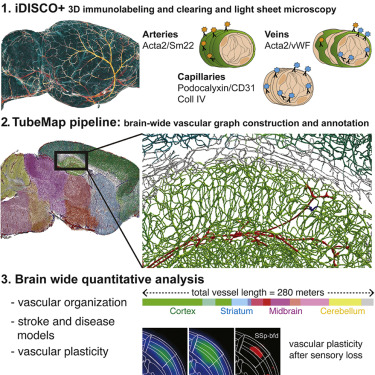ClearMap pipelines#
Introduction#
ClearMap is a toolbox for the analysis and registration of volumetric data from cleared tissues.
ClearMap has been designed to analyze terabyte-sized 3D datasets obtained via light sheet microscopy from iDISCO+ cleared tissue samples immunolabeled for proteins.
ClearMap has been written for mapping immediate early genes [Renier2016] as well as vasculature networks of whole mouse brains [Kirst2020]


ClearMap tools may also be useful for data obtained with other types of microscopes, types of markers, clearing techniques, as well as other species, organs, or samples.
ClearMap is written in Python 3 and is designed to take advantage of parallel processing capabilities of modern workstations. We hope the open structure of the code will enable many new modules to be added to ClearMap to broaden the range of applications to different types of biological objects or structures.
Installation#
For installation instructions, see Installation.
Usage#
This is a guide for advanced usage (including custom pipelines) of ClearMap. For basic usage see GUI usage.
Functionality and Pipelines#
ClearMap provides a larger set of high performance 3d image processing functions that are introduced here: Functionality.
These functions are combined together in expert functions under
Experts which are made use of in
pipelines found in Scripts to quantify the data sets.
CellMapPipeline
The main tools are:
ClearMap provides a stitching pipeline based on a custom algorithm implemented in the Wobbly Stitcher module.
The alignment pipeline is based on the Elastix library and provides the tools to align samples to a reference brain and to label discrete objects with the corresponding brain region.
The CellMap pipeline is used for high performance, parallelized cell detection, labeling and quantification.
The TubeMap pipeline is used for high performance, parallelized vasculature detection, labeling and quantification.
